Donald Clarence Judd (1928 – 1994)
Get a Judd Certificate of Authenticity for your painting or a COA for your Judd drawing or sculpture.
For all your Judd artworks you need a Certificate of Authenticity in order to sell, to insure or to donate for a tax deduction.
How to get a Judd Certificate of Authenticity is easy. Just send us photos and dimensions and tell us what you know about the origin or history of your Judd painting, drawing or sculpture.
If you want to sell your Judd painting, drawing or sculpture use our selling services. We offer Judd selling help, selling advice, private treaty sales and full brokerage.
We have been authenticating Judd and issuing certificates of authenticity since 2002. We are recognized Judd experts and Judd certified appraisers. We issue COAs and appraisals for all Judd artworks.
Our Judd paintings, drawings and sculptures authentications are accepted and respected worldwide.
Each COA is backed by in-depth research and analysis authentication reports.
The Judd certificates of authenticity we issue are based on solid, reliable and fully referenced art investigations, authentication research, analytical work and forensic studies.
We are available to examine your Judd painting, drawing or sculpture anywhere in the world.
You will generally receive your certificates of authenticity and authentication report within two weeks. Some complicated cases with difficult to research Judd paintings, drawings or sculpture take longer.
Our clients include Judd collectors, investors, tax authorities, insurance adjusters, appraisers, valuers, auctioneers, Federal agencies and many law firms.
We perform Donald Clarence Judd art authentication, appraisal, certificates of authenticity (COA), analysis, research, scientific tests, full art authentications. We will help you sell your Donald Clarence Judd or we will sell it for you. Please contact us for more information.
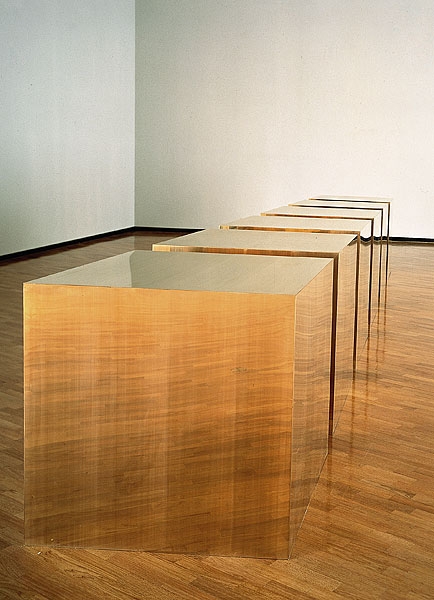
National Gallery of Australia
Donald Judd was an American Artist associated with the Minimalist movement, despite the fact that he did not like the term ‘minimalism’. Judd was born in Exelsior Springs, Missouri, where he remained, working as a military engineer, from 1946 to 1947. By 1948, Judd decided to study philosophy, first enrolling at the College of William and Mary and later at Columbia University in New York City. Judd earned his philosophy degree from Columbia and continued on to study art history at a postgraduate level. While working towards academic degrees, Judd began to attend fine art classes at the Art Students League of New York.
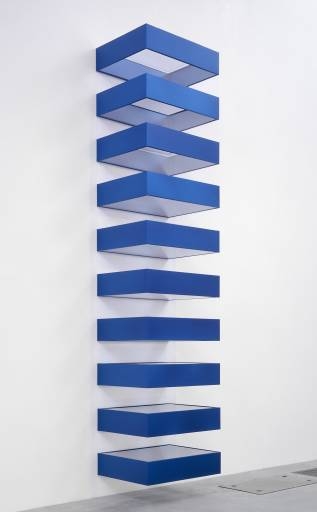
1990, Anodized Aluminum, steel and acrylic
Tate Gallery

1984.
Judd was able to support himself by writing art criticism for important art publications, distributed across the United States. Judd held his first solo exhibition in 1957, displaying a series of expressionist paintings. After this point, Judd began to change his style and focus on constructions made out of wood, metal and Plexiglas. When Judd had his next solo show in 1963, he showed a number of his constructions. Judd did not like to call his pieces paintings or sculptures, as they were made out of industrial materials. In 1966, Judd had another exhibit entitled
, which was held at the Jewish Museum of New York. The exhibition included a critical panel that discussed Judd’s contemporary practices.

1968, Enamel on Aluminum, 22 x 50 x 37.5 in
Guggenheim Museum, New York
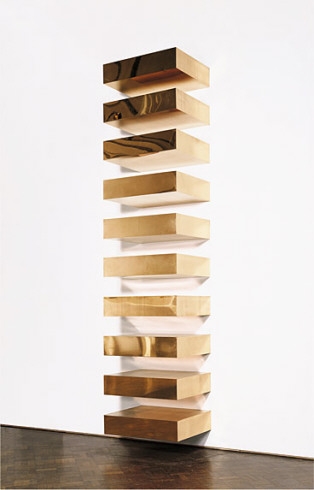
1969, Copper, 9 x 40 x 31 in
Guggenheim Museum, New York
In 1968, the Whitney Museum of American Art held a retrospective of Judd’s work, reaffirming Judd’s quick success. The same year Judd was able to purchase a five-story building in New York City. The building space allowed Judd to create installations and permanently install his pieces with some distance from external art institutions.
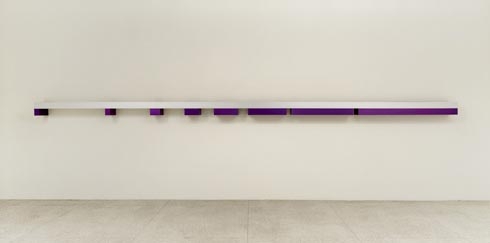
1970, Clear and purple anodized aluminum, 8.25 x 21 ft x 8 in
Guggenheim Museum, New York
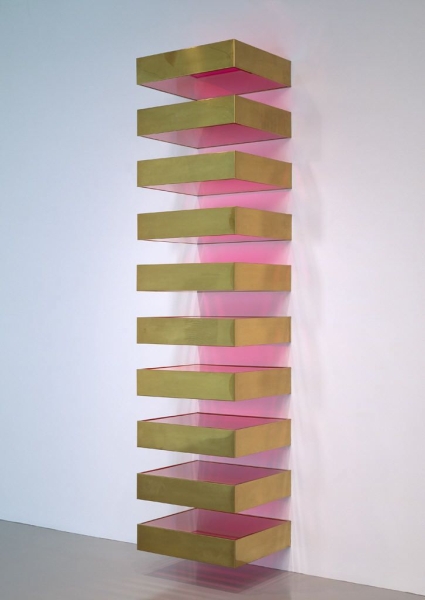
1969, Brass and colored fluorescent Plexiglas on steel brackets, 10 pieces: 6 1/8 x 24 x 27 in
Hirshhorn Museum
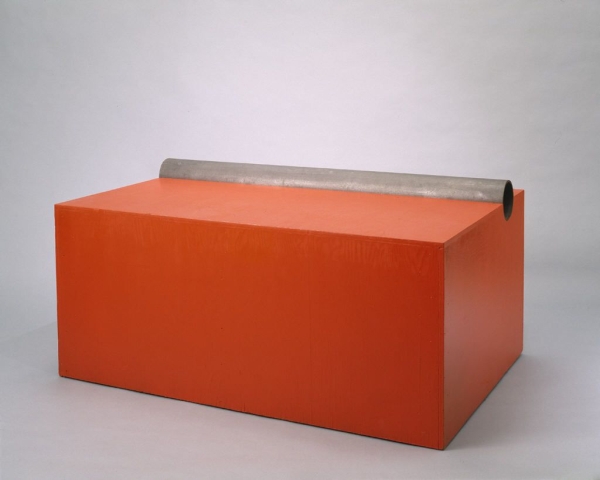
1963, Oil and Plywood with Iron Pipe, 56.2 x 115.1 x 77.5 cm
Hirshhorn Museum

1961, Oil on Composition board on wood with steel backing pan, 122.2 x 91.8 x 10.2 cm
Museum of Modern Art, New York
To escape from New York, Judd began travelling with his family to Baja, California and Marfa, Texas. Judd felt greatly inspired by the open spaces that he missed living in the city and decided to purchase several buildings in Texas with help from the Dia Art Foundation, including a ranch on the Chinati Hot Springs. On his Texas land, Judd was able to start the Chinati Foundation, a non-profit organization dedicated to the arts. The permanent collection in Texas included Judd’s contemporaries, including Carl Andre, Dan Flavin, John Chamberlain, Richard Long and Claes Oldenburg. When Judd was not in Texas or New York, he gave guest lectures at international universities and art centers.
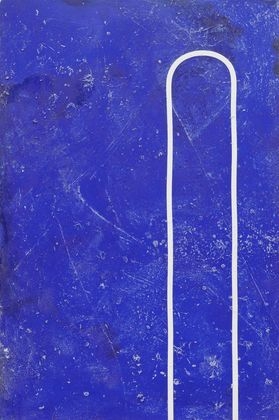
1961, Synthetic Polymer paint and sand, 183 x 121.7 cm
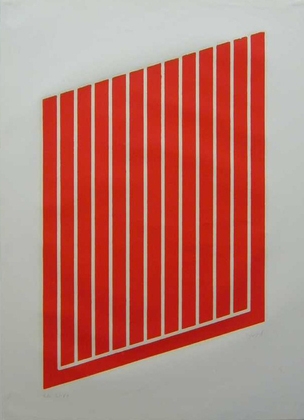
1961-96, Print on Paper, Series of 26 Woodcuts Image, 65.5 x 40.5 cm; sheet, 77.5 x 55.8 cm
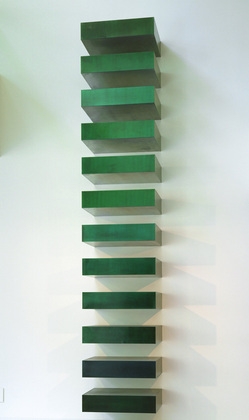
1967, Lacquer on Galvanized Iron, 22.8 x 101.6 x 78.7 cm
Museum of Modern Art, New York
In 1994, Judd died in New York City of lymphoma. Since his death, Judd’s foundation has continued to preserve his work, and he is now remembered as an important figure in American Art. Do you think you own a piece by Donald Judd? Contact us. We are the Donald Judd experts.
